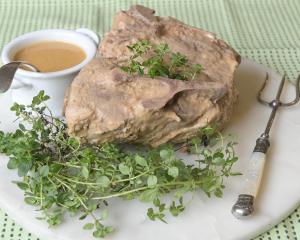
This wonderfully fresh-tasting and vibrant pesto mixes green peas, edamame beans and mint with the nuttiness of parmesan, writes Joan Bishop.

Dolloped atop baby pikelets, crusty fresh bread or brushetta, it is perfect for pre-dinner nibbles, as part of a classy afternoon tea and is easily transportable for picnics.
You can, of course, make your own pikelets but I cheat a bit and buy mine frozen. They are called Baby Blinis and available from a shop specialising in frozen food.
Green pea, edamame bean and mint pesto
SERVES 4-6 AS A NIBBLE
300g green peas, frozen, not minted
120g edamame beans, frozen (I buy these already shelled)
20g fresh mint leaves, about 2 handfuls
3 Tbsp extra virgin olive oil
3 Tbsp lemon juice
40g grated parmesan cheese
¾ tsp ground sumac
⅛th tsp chilli powder
salt to taste
Method
Cook the frozen peas according to the packet instructions. Drain and set aside to cool.
Cook the frozen edamame beans following packet instructions. Drain and set aside to cool.
Tip peas, beans, mint leaves, extra virgin olive oil, lemon juice, parmesan cheese, sumac and chilli powder into the food processor and pulse briefly until the pesto is well combined.
Taste, adding salt if needed.
Spoon the pesto into an attractive serving bowl, cover and refrigerate until needed.
Bring to room temperature to serve.
This can be served as a dip or guests can spread the pesto on to bases of their choice: baby pikelets, crackers, crostini or fresh crusty bread.
However, I usually place the pikelets on a large serving platter and top each with a generous spoonful of the pesto. Sometimes I spread each pikelet with a little cream cheese, add a thin sliver of smoked salmon then top with pesto.
Comments
Edamame beans are soy beans and are not good for you. Trypsin inhibitors in soy interfere with protein digestion. High levels of phytic acid in soy reduce assimilation of calcium, magnesium, copper, iron and zinc. Phytic acid in soy is not neutralized by ordinary preparation methods such as soaking, sprouting and long, slow cooking.












